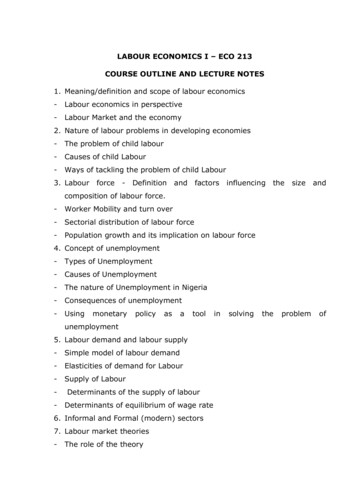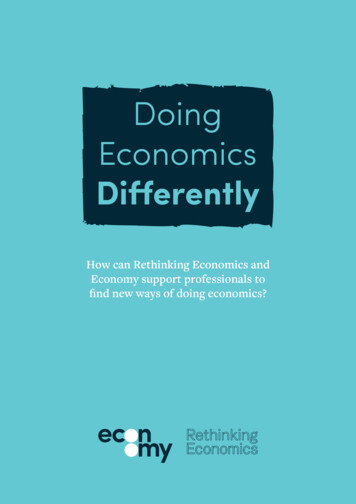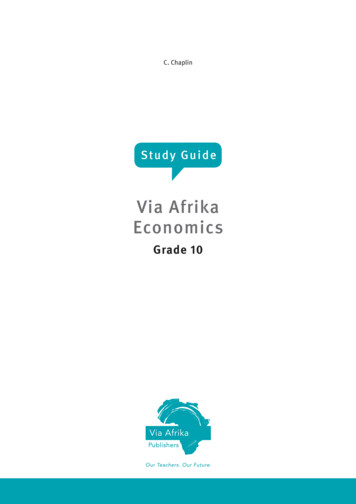
Transcription
LABOUR ECONOMICS I – ECO 213COURSE OUTLINE AND LECTURE NOTES1. Meaning/definition and scope of labour economics-Labour economics in perspective-Labour Market and the economy2. Nature of labour problems in developing economies-The problem of child labour-Causes of child Labour-Ways of tackling the problem of child Labour3. andcomposition of labour force.-Worker Mobility and turn over-Sectorial distribution of labour force-Population growth and its implication on labour force4. Concept of unemployment-Types of Unemployment-Causes of Unemployment-The nature of Unemployment in Nigeria-Consequences of t5. Labour demand and labour supply-Simple model of labour demand-Elasticities of demand for Labour-Supply of Labour-Determinants of the supply of labourDeterminants of equilibrium of wage rate6. Informal and Formal (modern) sectors7. Labour market theories-The role of the theoryinsolvingtheproblemof
-Types of labour market theories-Classical model of labour market theory8. Labour distribution-Types and factors affecting labour distribution in an economy-Industrial and occupational distribution of labour9. Economics of wage determination10.Features of Nigeria labour market11.Performance of the Nigeria labour market12.Manpower developmentINTRODUCTION OF LABOUR ECONOMICS:In previous lectures on economics adequate attention has been given to theconcept of economic. Economics problems, scope of economics and itsbranches, now, we introduce labour economics which is a subdivision ofeconomics.LABOUR – is one of the primary factors of production other factors include.Labour, capital and enterpreurship derived demand, these are input wederive. Note that labour is the collect name given to the productive service,embodied in human physical efforts, skill, intellectual power. e.t.c.There are different types of effort and skill content. This means that labourinput is not homogeneous according to the principle of economics production.Resources are relatively scarce or limited this means that the desire ofconsumer, business and governmental unit for goods and services exceed ourproductive capacity.Since resources are scarce and the want unlimited, society is obliged tomanage this resource efficiently. Labour economics therefore looks at wayslabour as a resource could be efficiently utilized.
DEFINITION LABOUR ECONOMICS:Labour economics is the branch of economics which studies the workings andoutcomes of the market for labour services, labour economics deals with thebehavior of employers and employees to the pecuniary (wages, prices,profits) and non-pecuniary (working conditions, work environmental) aspectsof the employment relationship firms operate in three markets as they pursuetheir objectives of profit maximization; the labour markets, the capital marketand the product market.It is the study of the labour force as an element in the process of production.Labour force comprises a part of the population which is employed oravailable for work.The labour force is made up of all those who work for gain whether asemployees, employers or as self-employed. It also includes the unemployedwho are seeking for employment.Labour economics is therefore the study of the factors affecting efficiency ofworkers, their development between different industries and occupations andthe determination of their pay.IMPORTANCE OF LABOUR ECONOMICS:The study of labour economics is importance for the following reasons.1. It helps economists to understand labour related problems e.g ,labourproductivity, workers safety, gender related matters, job security andJob satisfaction.2. The study important in providing data for economic planning and policye.g. It helps economists to know the contribution of labour services topeoples income (wages and salaries). There is evidence that in mosteconomy, labour input is the most of economic resources.
3. The study of labour economics helps us to understand the nature of themarket in which labour services are bought and sold.SCOPE OF LABOUR ECONOMICSLabour economics is concerned with issues that affect or concern the labourforce. Issues that concerns labour forces include;1. Labour mobility and migration2. Labour markets3. Supply of labour4. Unions and collective bargaining5. Work leisure decision6. Government and institutions7. Participation rates of Labour8. Wage structure9. Quality of labour10.Personal distribution of earning11.Labour productivity12.Wages and inflation13.Employment and unemploymentMost of the above issues are discussed under topics in micro economicstheory and macroeconomics.IMPORTANCE OF SOME OF THE SCOPES OF LABOUR ECONOMICS:1.Mobility of labour/worker mobility and Migration – it refers to theease with which labour can move from one occupation or geographical areato another. It has two components or aspects namely: Geographical mobility of labour: is the movement of labourbetween geographical locations or areas. That is mobility ofworkers from one region, country and location to another. If thepresent value of the benefits associated with mobility exceeds thecosts, both monetary and psychic, we assume that labour will
decide to change jobs or move, or both. Also if the discountedstream of benefits is not as large as the costs, then people willdecide not to change jobs. Occupational mobility of labour – it measures the extent towhich workers change occupation or skills in response todifferences on their wages or job availability.Migration is highly selective in the sense that it is not an activity in which allpeople are equally likely to be engaged. To be specific, mobility is muchhigher among the young and better educated than the old.Characteristics of Migrantsa.Age: is the single most important factor in determining whomigrates. The peak years for mobility are 20 – 24; 12% of thisage group migrates across the country or state lines each year.By age 32 the rate of migration begins to drop gradually and byage 42 it drops very low. There are two reasons for this situation.Firstly, migration is greater among the young with greatpotentials and ability totakehighrisk. They bring highinvestment returns from any human capital investment.Secondly, a large part of the cost of migration are psychic, thelosses associated with giving up friends, community ties, andbenefits of knowing ones way around can easily be forgonebecause at such early adult age one is not yet established as amatured adult. However as one grows older such things begin tocount.b.Education: while age is the best indicator of who will move,education is the best indicator of who will move within the agegroup. Educated people tend to want to migrate more to areaswhere they can find good jobs with high wages and incentiveswithin the country or outside the country. One cost of migration is
ascertaining where the opportunities exist and how lucrative arethe jobs.c.The role of distance: As the cost of migration gets higher thedesire for mobility reduces as a result. There is also the cost ofgetting relevant information of where opportunities exist. This caneither encourage or discourage labour from migrating.2. Labour Market:- It is the market in which wages and conditions ofemployment are determined. Remember that in the market system the forcesof demand and supply determine commodity prices while in the labourmarket, what we talk about is service and the wages for labour services.Note: Labour services are not homogenous, they are classified based on thequality of skills requirement.3. Supply of Labour – number of hours of labour service that the workingpopulation is prepared to offer within a given period of time and at a givenwage rate4.Union and Collective Bargaining – This is a negotiation and theagreement between the employer and the employee.Collective bargaining is the establishment by negotiation and discussion ofagreement on matters of mutual conscience to employers and to conditionsofemployment within and about a disputed matters that can lead to disorderconsidered or may be considered with the aim of taking care of the problemsor issues and averting the disorder.Nature of Labour Problem in Developing Economies Or Countries:Labour Problem can be defined as the problem of improving the conditions ofemployment of the wage-earning classes. It encompasses the difficultiesfaced by wage-earners and employers who began to cut wages for variousreasons including increased technology, desire for lower costs or to stay inbusiness at all cost. The wage-earning classes responded with strikes, byunionizing and by committing acts of outright violence.
It was a nationwide problem that spanned nearly all industries and helpedcontribute to modern business conditions still seen today. Possible causesinclude the failure to account for the negative externality of reproduction inthe face of finite natural resources which results in over-supply of labor andfalling living standards for wage-laborers, depersonalization by machines andpoor working conditions.Most developing economies have labour related problems, such problemsinclude:1. Shortage of labour – many developing countries lack skilled labour. Thereasons are because majority of the population are not skilled or semiskilled labour. For that reason they use expertise (foreigner) inproductions that need high level skilled manpower.2. Most people who are working receive low wage payments which arecommon among employees who have no skills or are semi-skilled. Thatis those who have little or no education.3. Labour is abundant for agriculture, while there is less labour forindustries, commerce and services.4. Government is the chief employer of labour. While the employment bythe organize private sector is minimal in such economy.5. Labour force problem is a characteristic of many self-employed artisanswho are not organized nor have anything to do with government,government institutions or the organized private sector.Labour Problems in NigeriaWe have identified the following as some of the labour problems in Nigeria;1. Disparity between the supply of labour and the demand forlabour force: This does not march with a corresponding increase in jobopportunities. The total number of youths and graduates who arewilling and ready to participate in the labour market cannot find placesto work.
The implication is that the supply for labour is more than the demandfor labour. Under such situation the wage rate will be affectednegatively. The rate could even fall below the market equilibrium underthe free enterprises economy.The effect is that supply of labor increases while it demands fallsdrastically and at the end of the day, the problem compounds into lowwage payments.2. Series of Industrial conflict – conflicts take the form of strike andother destructive form of man-days are lost and production activitiesare also stoped. In the same way important services that could havecontributed to economic developement and to human welfare are heldby the labour force. These are thought to affect negatively the pace ofeconomic development especially in less developed Countries (LDCs).It affects all economic activities of the state, thus determination ofwages are no longer triggered by the free interplay of the forces ofdemand and supply.3. The role of inflation – The problem of inflation has serious negativeinfluence in the labour market. Inflation gives rise to the prices of thefactors of production. Similarly it has influence in the commodity price;it leads to low production because of its effect on the factors price.Inflation is most times heightened by low production, money launderingor structural defects which are very peculiar to the Nigerian economy.4. Consistent failure of imported ideas or strategies: In the pastyears most imported ideas, approaches and strategies have failed towork in Nigeria. Non workability of the ideas is attributed to differencesin collective and historical background. Attempt to emulate foreignideas or policies would end up aggravating the problems already facedin the Nigerian labor market rather than solving them.
5. Insecurity – This is one of the major problem facing the labour forcein Nigeria. It is more pronounced in the labour sector and amongst ouryouths.6. Violation of Institutional Arrangements: Wages are supposed to benegotiated and not rewarded. Basically there is always an institutionalarrangement for wage determination which could either be by collectivebargaining, labor courts or sometimes the police force.Unfortunately the institutional arrangements are completely violatedand flawed by the state which of course distorts the flow or functioningof the labor market. A very good example is the award of wages toworkers by the state.7. The problem of informalization of the economy: It is one of thelabour problems faced by Nigeria. It has caused labour issues and hasaffected the demand of labour in the labour market.8. Mismatch of skills: This is one of the major problems in the Nigerianlabour market and it is greatly affecting the demand for labour in themarket.9. Geographical mismatch, political and regional interference andregional differences or crisis are some of labour problems in Nigerian.THE PROBLEM OF CHILD LABOUR:The problems of child Labour exist throughout the world. It is howevercommon in developing countries, particularly rural areas where the capacityto enforce minimum age requirements for schooling and work does not exist.Here children are being exploited and forced into child labour. They have littleor no chance of receiving formal education. Children in this category areworking objects of extreme exploitation with minimal wage.The conditions under which these children work in most developing countriesare very severe. They are often not provided the sanitation for properphysical and mental development.
In most countries of the world there are restriction on child labour but notfollowed in many developing countries. Most state leaves these childrenvulnerable to exploitation. Child labors are the worst paid categories in theworld. They face health hazards and potential abuse. Most employers takeundue advantage of child laour knowing that they cannot legally form unionsto change their conditions of employment.This manipulation stifles the development of youths in the society. Theworking conditions of these children do not provide the stimulation for properphysical and mental development. Consequently, these children are deprivedof the simple joy of childhood. (Gbosi, 2005).There is no uniform international law or agreement that defines child labour.Many countries have different minimum age for work restrictions.Causes of Child Labour:The following are the causes of child labour;1.Poverty: Children in the child labour category work for many reasons.The most important is poverty. Children work to ensure the survival oftheir family and themselves. Children are paid far less than adults. Theincome they earn is of benefit to their poor families. One of the reasonwhy parents have in developing countries is because they can beprofitable.In Nigeria about 14.2 million children are engaged in child labour. Thisis as a result of the high incidence of poverty in the country.2.Schooling Problems: The school problems contribute to child labour.Many times children seek employment because they don’t have accessto schools or good education. Even when there is access to education,the low quality of education often makes attendance a waste of time formost students.In Nigeria, poor parents believe that the poor quality of education andcondition of overcrowding, inadequate sanitation and apathetic teachersmake education a waste of time. They prefer their children learning askill and thereby supplementing the family income. Parental educationplays a major role in determining child schooling and employment.
3.Traditional Factors: In Africa most female children, based on culturalbelieve and traditional believe that women will not fit into native roles ifthey become educated. They believe that educated women will not getmarried or have children. Therefore many families prefer their femalechildren to take over household duties. The intended purpose is torelease mothers for paid employment in many developing countries.Such cultural practices eventually restrict the education of females andpromote child employment in many developing countries. This makecertain siblings going to school while others work.4.Rapid Rural Urban-Migration: This is another reason for theincreasing rate of child labour in urban areas of developing countries.Families leave the severity of agricultural working conditions for cities inorder to search for economic opportunities that often do not exist. Thismovement has been drastic rural urban migration in most developingcountries.Such increases coupled with worsening economic trends, force childrenand their families into urban poverty. Thus children are forced into childlabour or required to work.Ways of Tackling the Problem of Child Labour:1.Improved quality education: This is one of the ways to tackle theproblem of child labour. If the governments improve the quality ofeducation, the value will increase to children and parents. Schoolrepresents the most important means of drawing children away fromthe labour market. School provides children with guidance andopportunity to understand their role in the society. Therefore there isneed to adequately fund all levels of education in developingcountries.2.Provision of Subsidies: Poor families should be provided withsubsidies prone to having children. This will enable them afford theirchildren’s school fees and other fees associated with attendance. The
issue of poverty should be addressed so as to reduce the level ofchild labour.3.Establishing partnership with International dnation(UN),theInternational Labour Organization (ILO), the World Bank, theInternational Monetary Fund (IMF) and other international agenciesshould be encouraged to assist government of developing countriesin the area of financial aid, public enlightenment campaigns and theestablishment of a world labour court. The court should be chargedwith handling matters relating to the problems of child labourthroughout the globe.SECTORAL DISTRIBUTION OF LABOUR FORCELabour force is that part of the population which is employed or available forwork. It can also be defined as everyone who is classified as either Employedor Unemployed. The available labour services to the society depend on thefollowing:1. The size and demographic composition of the population.2. The labour force participation rate – that means the percentage of theworking age which is actually working or seeking job.3. The number of work hours per year or month or week or day or hour4. The quantity of labour force – labour input is provided in form ofservices, the total productive effort available in the economy dependsupon a number of factors that leads to the factors that determine thesize and composition of labour force.By Sectorial Distribution of Labour Force, we mean the number orpercentage of persons that are gainfully employed in various sectors of thenational economy. During the recent years there has been a fluctuation in themanufacturing sector and it contributed to a total high of gainful employmentwhen compared with other sectors as electricity, gas, and water and mining
respectively. The breakdowns of the various groups in the country are aslisted below;Nigeria: Female Labor force participation rate:Female labor force is a percentage of the total that show the extent to whichwomen are active in the labor force. Labor force comprises people ages 15and older who meet the International Labour Organization's definition of theeconomically active populationThe World Bank provides data for Nigeria from 1990 to 2014. The averagevalue of women for Nigeria during that period was 39.9 percent with aminumum of 34.13 percent in 1990 and a maximum of 42.95 percent in2004. As at 2014 the female labour force in Nigeria stood at 42.4%Nigeria: Male labor force participation rate:The male labor force participation rate is the percent of the male populationages 15 and older who are economically active. That includes the employedpeople as well as the unemployed people.The World Bank provides data for Nigeria from 1990 to 2014. The averagevalue for Nigeria during that period was 66.79 percent with a minumum of61.9 percent in 2004 and a maximum of 74.8 percent in 1990. As at 2014 themale labour force participation rate stood at 63.8%.Nigeria: Dependent people as percent of the working age population:The age dependency ratio for Nigeria is calculated as follows: Agedependency (people younger than 15 and older than 64) /(working age people ages 15-64). A higher value for Nigeria and othercountries means that employed people have to support more non-workingpeople, either young or old.The World Bank provides data for Nigeria from 1960 to 2015. The averagevalue for Nigeria during that period was 86.93 percent with a minumum of79.98 percent in 1960 and a maximum of 92.37 percent in 1987. By 2015 thepercentage of dependent age stood at 87.71%Nigeria: Youth unemployment, ages 15-24:The Rate of youth unemployment for Nigeria is the percent of 15-24 year oldswho are part of the labor force but are unemployed. Recall that the laborforce includes the employed and the unemployed people.The World Bank provides data for Nigeria from 1991 to 2014. The averagevalue for Nigeria during that period was 13.72 percent with a minumum of13.6 percent in 1991 and a maximum of 14.2 percent in 2002. By 2014 thepercentage of unemployed youths in Nigeria was 13.6%.
Nigeria: Unemployment rate for females:Female unemployment rate for Nigeria is the percent of 15-64 year olds whoare part of the labor force but are unemployed. Recall that the labor forceincludes the employed and the unemployed people.The World Bank provides data for Nigeria from 1991 to 2014. The averagevalue for Nigeria during that period was 7.37 percent with a minumum of 7.1percent in 2002 and a maximum of 7.5 percent in 1999. The figure for 2014was 7.3%.Nigeria: Unemployment rate for males:Male unemployment rate for Nigeria is the percent of 15-64 year olds who arepart of the labor force but are unemployed. Recall that the labor forceincludes the employed and the unemployed people.The World Bank provides data for Nigeria from 1991 to 2014 of the maleunemployed. The average value for Nigeria male during that period was 7.65percent with a minumum of 7.4 percent in 1991 and a maximum of 8 percentin 2002. By 2014 the figure of male unemployed in Nigeria stood at 7.6%.Population growth and its implication on labour force:As at Nigeria’s independence and in recent years, the large size of thepopulation was considered an asset to the country. However in relation to hercurrent resources, the rapid growth of the population became a source ofconcern. For instance, from an estimate of 28.6 and 58.5 million person in1960 and 1970 respectively, the Nigerian population grew rapidly at anannual rate of 21.0% to 62.8%, 70.2% and 79.1% in 1975 and 1980respectively.Since 1980 there had been a phenomenal growth in Nigeria’s population. In1985 Nigeria’s population was at 79.0 million. But by 2005, it has risen to anunprecedented high of 140million people. And by 2010 it rose to over 158.8million people (NBS, 2010).Today most economic analysts believe that the Nigeria’s population is as highas 200 million people.With these population sizes, the major consequence of the gallopingpopulation growth and rapid urbanization is mounting unemployment,especially in the urban centers in the face of rising rural – urban migration.
At this time the rural agricultural labour force declined rapidly from 75% ofthe total in 1970 to 55% in 1985. For a labour intensive dominant agriculturalsector, productivity declined dramatically. The high level of population in thecities led to high levels of unemployment and hardship on the populace.According to CBN in 2004 the number of unemployed persons in the countryregistered with the Employment Exchange Offices increased dramatically by12.43% to 402.382%. In recent years the figure has gone so high.Nigeria: Unemployment rate:The unemployment rate in Nigeria is defined as the number of unemployedpeople as a percent of the labor force. The labor force includes the peoplewho are either employed or unemployed, i.e. who don't have a job but areactively looking for one.The labor force does not include people who are not looking for work,children,andtheretired.The unemployment rate seldom declines below 4-5 percent even during boomtimes. There are always people who move between different sectors of theeconomy or between cities. When the economy goes into recession, thenunemployment can reach much higher numbers, sometimes even in thedouble digits.The World Bank provides data for Nigeria from 1991 to 2014. The averagevalue for Nigeria during that period was 7.54 percent with a minumum of 7.4percent in 1991 and a maximum of 7.7 percent in 2002. By 2014 theunemployment rate was 7.5%.Factors that affect the size of Labour ForceFactors affecting the size of a labor force include population, income,educational attainment, home ownership, number of industries andgovernment policies. Economic Online reveals that a 1 percent growth instate population causes a 0.74 percent growth in the size of the labor force.Additionally, an increase in minimum wage causes an increase in the size of alabor force.According to Economic Online, home ownership has many benefits to thesociety, but it reduces employee mobility, decreasing the size of a labor force.An increase in the wage rate reduces the demand for labor, reducing the sizeof a labor force. On the other hand, high productivity increases the demandfor labor and the size of a labor force.The supply of labor also affects the size of a labor force. Immigrationincreases the size of a labor force while migration reduces it. Preference forwork also affects the size of a labor force because the benefits of working
motivate people to seek employment. Trade unions prevent a decrease in thesize of a labor force by protecting the rights of workers.The cost of living has no impact on the size of a labor force. Labor forceincludes the unemployed because of their potential for employment withinformal and informal sectorsFactors that determine the size and composition of labour force:1. Population size - Labour force is part of the population, therelationship between the population and labour force depends on birthrate, death rate and net immigration. Other demographic factorsinclude:a. Age composition of the population – This helps to determine thelabour force.For example in Nigeria age eligible population that canparticipate in labour force is within 15-64 years. Because they arequalified to belong to the labour force. The more we have people withinthis range the more the size of the labour force.b. Sex composition of the population – in any economy where thepopulation skew favor any particular sex, for instance more men, itmean that more members of the population will be available for workwhether skilled or unskilled.2. Labour force participation rate of the population:Participation rate means the percentage of the working age populationwhich is actually working or seeking for work. Labour force participationrate is determined by compiling the actual with the potential labourforce or what is called the age eligible population.I.Potential labour force – The potential labour force or age eligiblepopulation is defined as the entire population less (i) young peoplesunder 15 years of age and the (ii) peoples who are institutionalized,children under 15 years of age are excluded on the assumption that insome countries schooling and child labour laws keep most of them outof the labour force.II.Actual labour force – It consists of those people who are eitheremployed or unemployed but actively seeking a job. In percentage form
labour force participation rate is expressed as actual labour forcedivided by potential labour force multiply by 100. i.e.actual labourforce x 100Potential labour force3.The average number of hours worked weekly and annually: Bythis the labour force minus the total amount of labour supplied in theeconomy does not depend only on the number of labour force thatparticipates but also on the average no of hours worked per week and peryear by those participants. Experience show that work week decline onweekly basis as follows:a. Workers income – leisure preferencesb. Non-wage income – if non-wage income increases, the no ofworking hours will reduce.c. Assumption that leisure is a normal goods4. People attitude to work: General attitude of people in a particularsociety will affect the size of the labour force. In countries where those whobelong to the labour force do not depend on the unemployment effort orany form of it (Social allowance or Benefit). The size of labour force wouldbe large. In such a situation people will be willing to provide labour servicesfor their up keep.5.Quality of labour: A qualitative or superior labour force is one that ismore experienced, more educated and better trained. Productivity of labourmay be considering an investment in human capital. Human capitalinvestment include expenditures on:a. Formal educationb. On the job trainingc. Health and migrationWorker can become more productive by;(i)Improving their physical and mental health(ii)By moving from locations and jobs where their productivity isrelatively low to where their productivity is relatively high.
6.Legal requirement on women participation in the l
9. Economics of wage determination 10. Features of Nigeria labour market 11. Performance of the Nigeria labour market 12. Manpower development INTRODUCTION OF LABOUR ECONOMICS: In previous lectures on economics adequate attention has been given to the concept of economic. Economics problems, scope of economics and its










